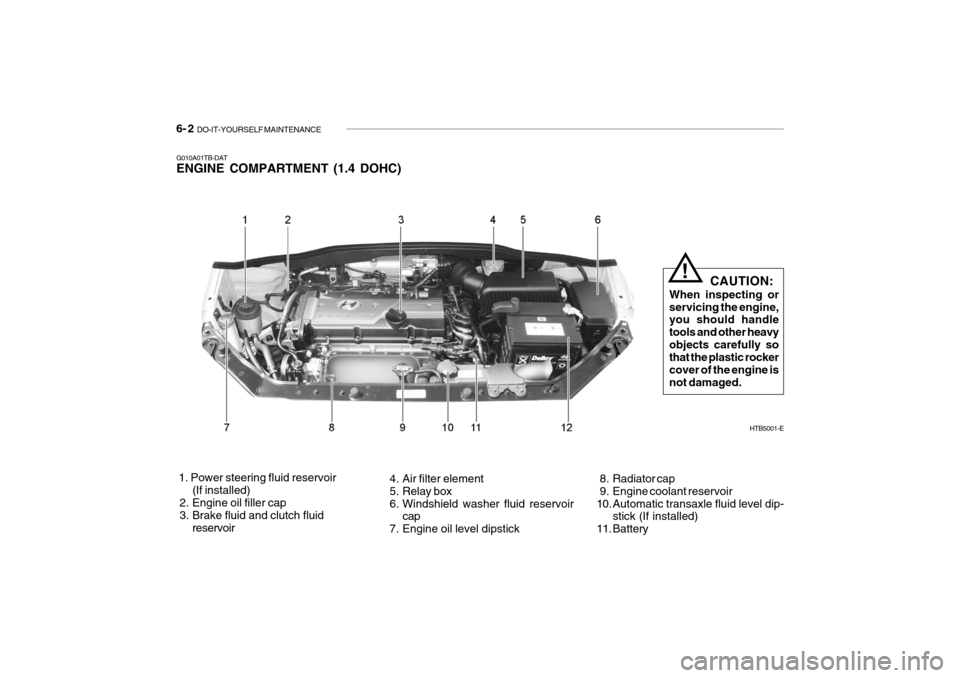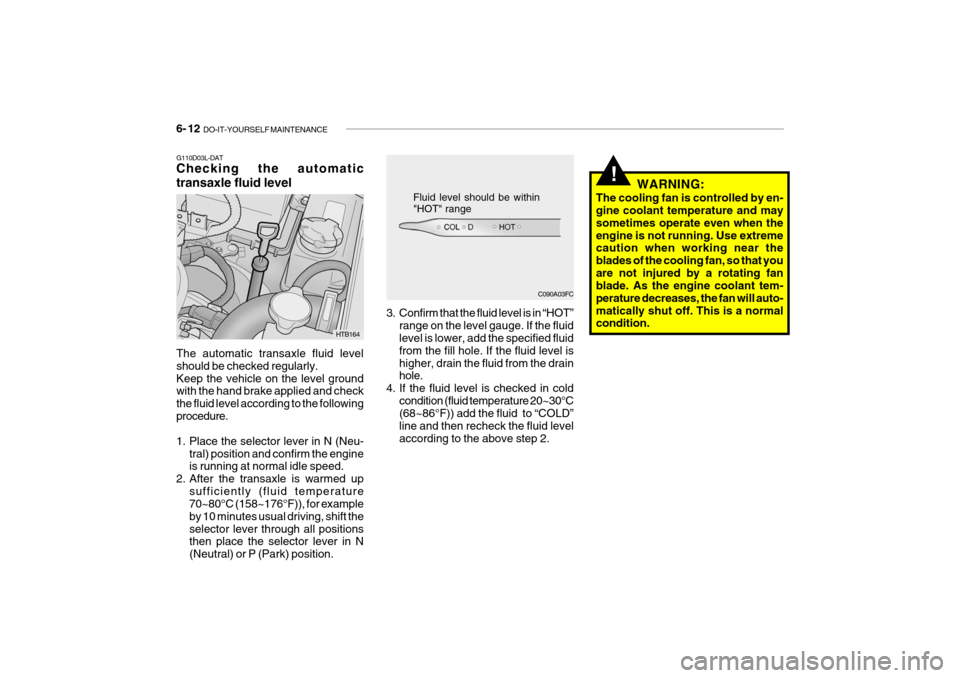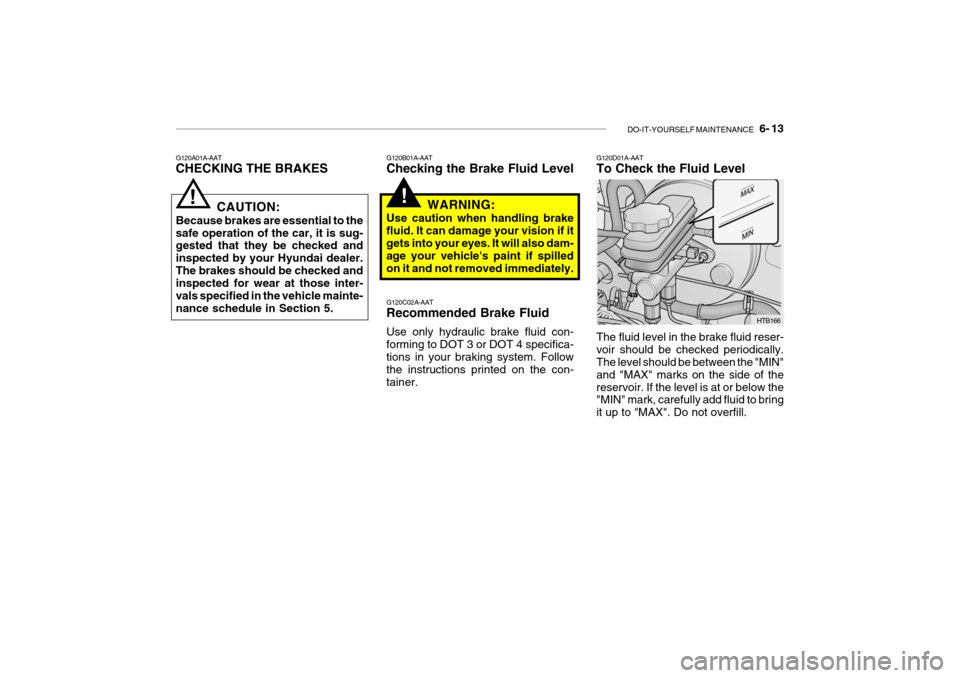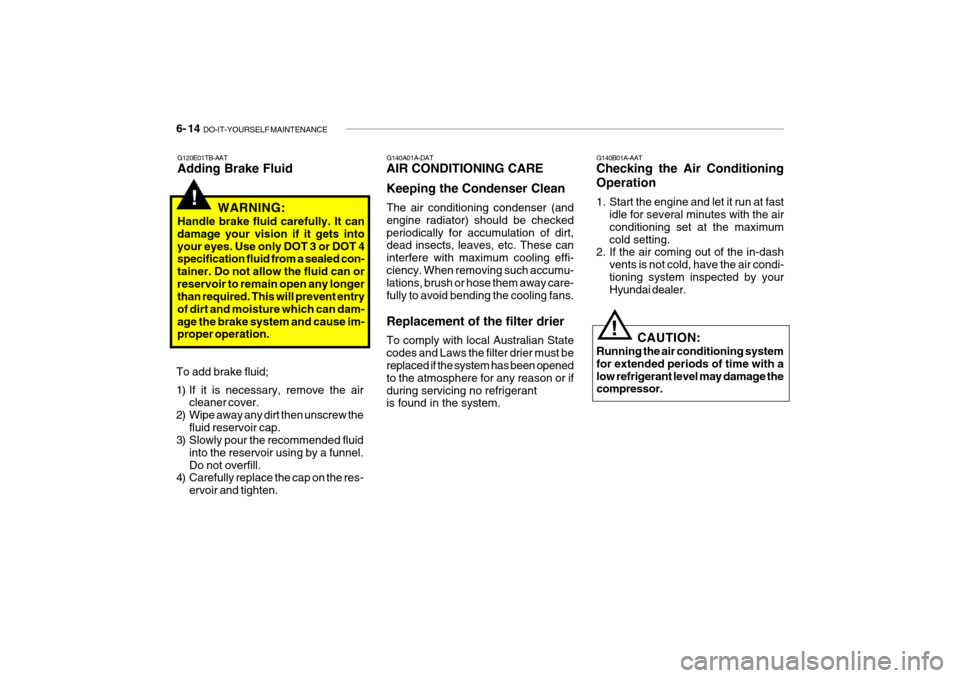2009 Hyundai Getz brake fluid
[x] Cancel search: brake fluidPage 144 of 191

6- 2 DO-IT-YOURSELF MAINTENANCE
G010A01TB-DAT ENGINE COMPARTMENT (1.4 DOHC) 1. Power steering fluid reservoir
(If installed)
2. Engine oil filler cap
3. Brake fluid and clutch fluid
reservoir 4. Air filter element
5. Relay box
6. Windshield washer fluid reservoir
cap
7. Engine oil level dipstick 8. Radiator cap
9. Engine coolant reservoir
10. Automatic transaxle fluid level dip-
stick (If installed)
11. Battery HTB5001-E
CAUTION:
When inspecting or servicing the engine, you should handle tools and other heavyobjects carefully so that the plastic rocker cover of the engine isnot damaged.!
Page 145 of 191

DO-IT-YOURSELF MAINTENANCE 6- 3
G020A01A-AAT GENERAL CHECKS Engine Compartment The following should be checked regu-larly:
o Engine oil level and condition
o Transaxle fluid level and condition
o Brake fluid level
o Clutch fluid level
o Engine coolant level
o Windshield washer fluid level
o Accessory drive belt condition
o Engine coolant hose condition
o Fluid leaks (on or below compo-
nents)
o Power steering fluid level
o Battery condition G020C01A-DAT Vehicle Interior The following should be checked each time when the vehicle is driven:
o Lights operation
o Windshield wiper operation
o Horn operation
o Defroster, heating system operation
(and air conditioning, if installed)
o Steering operation and condition
o Mirror condition and operation
o Turn signal light operation
o Accelerator pedal operation
o Brake operation, including hand brake
o Manual transaxle operation, includ- ing clutch operation
o Automatic transaxle operation, in- cluding "Park" mechanism operation
o Seat control condition and operation
o Seat belt condition and operation
o Sunvisor operation If you notice anything that does not operate correctly or appears to be functioning incorrectly, inspect it care- fully and seek assistance from yourHyundai dealer if service is needed.
G020B01A-DAT Vehicle Exterior The following should be checked monthly:
o Overall appearance and condition
o Air filter condition
o Wheel condition and wheel nut torque
o Exhaust system condition
o Light condition and operation
o Windshield glass condition
o Wiper blade condition
o Paint condition and body corrosion
o Fluid leaks
o Door and bonnet lock condition
o Tyre pressure and condition (includ-
ing spare tyre)
Page 154 of 191

6- 12 DO-IT-YOURSELF MAINTENANCE
!
G110D03L-DAT Checking the automatic transaxle fluid level The automatic transaxle fluid level should be checked regularly.Keep the vehicle on the level ground with the hand brake applied and check the fluid level according to the followingprocedure.
1. Place the selector lever in N (Neu-
tral) position and confirm the engine is running at normal idle speed.
2. After the transaxle is warmed up sufficiently (fluid temperature70~80°C (158~176°F)), for example by 10 minutes usual driving, shift theselector lever through all positions then place the selector lever in N (Neutral) or P (Park) position. C090A03FC
Fluid level should be within "HOT" range
HTB164 3. Confirm that the fluid level is in “HOT”
range on the level gauge. If the fluid level is lower, add the specified fluid from the fill hole. If the fluid level ishigher, drain the fluid from the drain hole.
4. If the fluid level is checked in cold
condition (fluid temperature 20~30°C(68~86°F)) add the fluid to “COLD” line and then recheck the fluid levelaccording to the above step 2. WARNING:
The cooling fan is controlled by en- gine coolant temperature and may sometimes operate even when theengine is not running. Use extreme caution when working near the blades of the cooling fan, so that youare not injured by a rotating fan blade. As the engine coolant tem- perature decreases, the fan will auto-matically shut off. This is a normal condition.
Page 155 of 191

DO-IT-YOURSELF MAINTENANCE 6- 13
G120A01A-AAT CHECKING THE BRAKES
!
CAUTION:
Because brakes are essential to the safe operation of the car, it is sug- gested that they be checked and inspected by your Hyundai dealer.The brakes should be checked and inspected for wear at those inter- vals specified in the vehicle mainte-nance schedule in Section 5.!
G120B01A-AAT Checking the Brake Fluid Level
WARNING:
Use caution when handling brake fluid. It can damage your vision if itgets into your eyes. It will also dam- age your vehicle's paint if spilled on it and not removed immediately. G120C02A-AAT Recommended Brake Fluid Use only hydraulic brake fluid con- forming to DOT 3 or DOT 4 specifica- tions in your braking system. Follow the instructions printed on the con-tainer. G120D01A-AAT To Check the Fluid Level
HTB166
The fluid level in the brake fluid reser- voir should be checked periodically. The level should be between the "MIN" and "MAX" marks on the side of thereservoir. If the level is at or below the "MIN" mark, carefully add fluid to bring it up to "MAX". Do not overfill.
Page 156 of 191

6- 14 DO-IT-YOURSELF MAINTENANCE
G140A01A-DAT AIR CONDITIONING CARE Keeping the Condenser Clean The air conditioning condenser (and engine radiator) should be checkedperiodically for accumulation of dirt, dead insects, leaves, etc. These can interfere with maximum cooling effi-ciency. When removing such accumu- lations, brush or hose them away care- fully to avoid bending the cooling fans. Replacement of the filter drier To comply with local Australian State codes and Laws the filter drier must be replaced if the system has been opened to the atmosphere for any reason or ifduring servicing no refrigerant is found in the system.
!
G120E01TB-AAT Adding Brake Fluid
WARNING:
Handle brake fluid carefully. It can damage your vision if it gets intoyour eyes. Use only DOT 3 or DOT 4 specification fluid from a sealed con- tainer. Do not allow the fluid can orreservoir to remain open any longer than required. This will prevent entry of dirt and moisture which can dam-age the brake system and cause im- proper operation.
To add brake fluid;
1) If it is necessary, remove the air cleaner cover.
2) Wipe away any dirt then unscrew the fluid reservoir cap.
3) Slowly pour the recommended fluid
into the reservoir using by a funnel. Do not overfill.
4) Carefully replace the cap on the res-
ervoir and tighten.
!
G140B01A-AAT Checking the Air Conditioning Operation
1. Start the engine and let it run at fast
idle for several minutes with the air conditioning set at the maximumcold setting.
2. If the air coming out of the in-dash
vents is not cold, have the air condi-tioning system inspected by your Hyundai dealer.
CAUTION:
Running the air conditioning system for extended periods of time with alow refrigerant level may damage the compressor.
Page 186 of 191

9- 4 VEHICLE SPECIFICATIONS
Oil & Grease Standard
API SJ, SL SAE 5W-20, 5W-30
or ABOVE, SAE 10W-30 (ABOVE -18°C)
ILSAC GF-3 SAE 15W-40 (ABOVE -13°C)
or ABOVE SAE 20W-50 (ABOVE -7°C) Normal driving conditionSevere driving condition HYUNDAI GENUINE PARTS MTF 75W/85 (API GL-4) HYUNDAI GENUINE ATF SP III, DIAMOND ATF SP III,SK ATF SP III or other brands approved by Hyundai Motor Co., PSF-3 DOT 3, DOT 4 or equivalentEthylene glycol base for aluminum radiator
Item
Engine Oil
Engine Oil Consumption
Transaxle Manual
Auto
Power Steering Brake FluidCoolant
J080A02TB-DAT LUBRICATION CHARTQ'ty (litre)
Drain and refill (with oil filter) : 3.3 (2.9 Imp.qts) MAX. 1L / 1,500 Km MAX. 1L / 1,000 Km2.15 (1.86 Imp. qts) 6.1 (5.3 Imp.qts) As required As required 5.5(4.8 Imp.qts)
Page 188 of 191

10- 2 INDEX
A
Air Bag ....................................................................... 1-28
Air Cleaner Filter .......................................................... 6-8
Air Conditioning Care ......................................................................... 6-14
Operation ................................................................. 1-78
Switch ...................................................................... 1-77
Air Conditioner filter .......................................... 1-73, 6-15
Antenna ...................................................................... 1-84
Ashtray ....................................................................... 1-53
BBattery .............................................................. 2-16, 6-20
Bi-Level Heating ......................................................... 1-74
Bonnet Release .......................................................... 1-62
Brake
Anti-lock system ...................................................... 2-12
Checking the brakes ................................................ 6-13
Fluid ......................................................................... 6-14
Pedal clearance ....................................................... 6-17
Pedal free play .......................................................... 6-17
Practices ................................................................. 2-11
Bulb Replacement ...................................................... 6-24
Bulbs wa ttage ............................................................. 6-29C
Care of Cassette Tapes
............................................. 1-82
Catalytic Converter ...................................................... 7-3
Child-Protector Rear Door Lock ................................... 1-6
Child Restraint System ............................................... 1-23
Cigarette Lighter ......................................................... 1-52
Clock .......................................................................... 1-51
Clutch Pedal freep lay .......................................................... 6-17
Combination Light Headlight flasher ...................................................... 1-47
Headlight swi tch ...................................................... 1-46
High-beam switch .................................................... 1-47
Lane change si gnal .................................................. 1-46
Turn signal operation ............................................... 1-46
Console tray ............................................................... 1-54
Cooling Fans .............................................................. 6-22
Corrosion protection Cleaning the interior .................................................. 4-5
Protecting your Hyundai from corrosion ................... 4-2
Washing and waxing ................................................. 4-3
DDefrosting / Defogging ................................................ 1-76
Door Door locks ................................................................ 1-4Locking, unlocking front doors with a key ................ 1-5